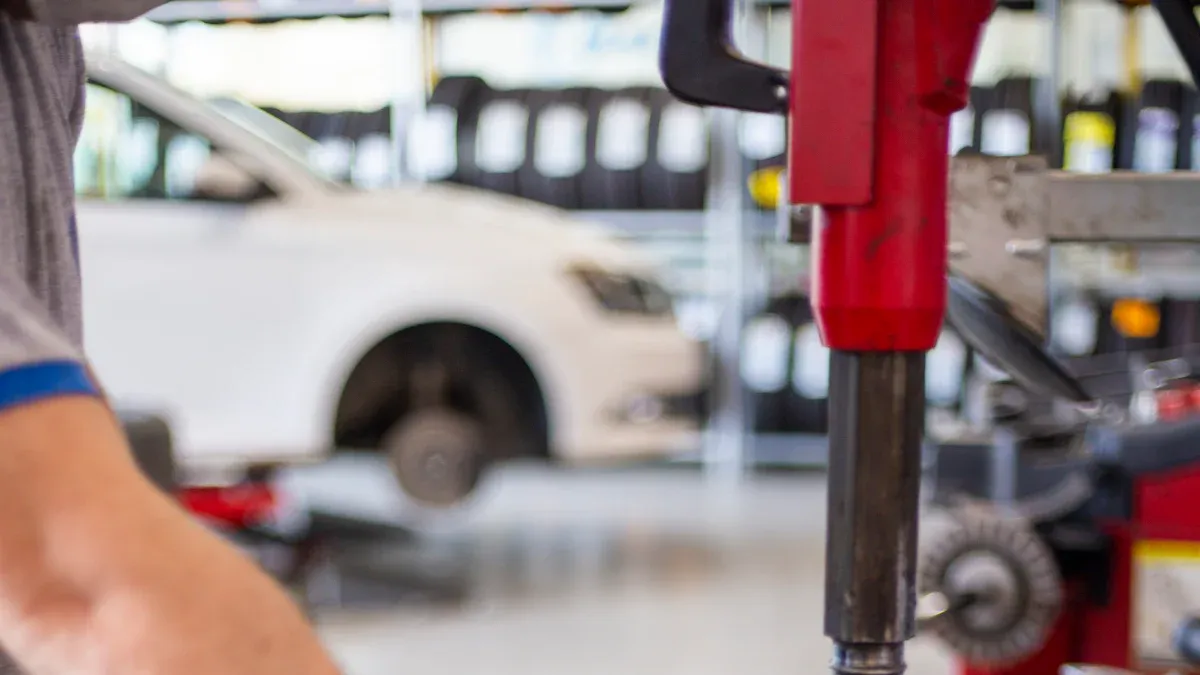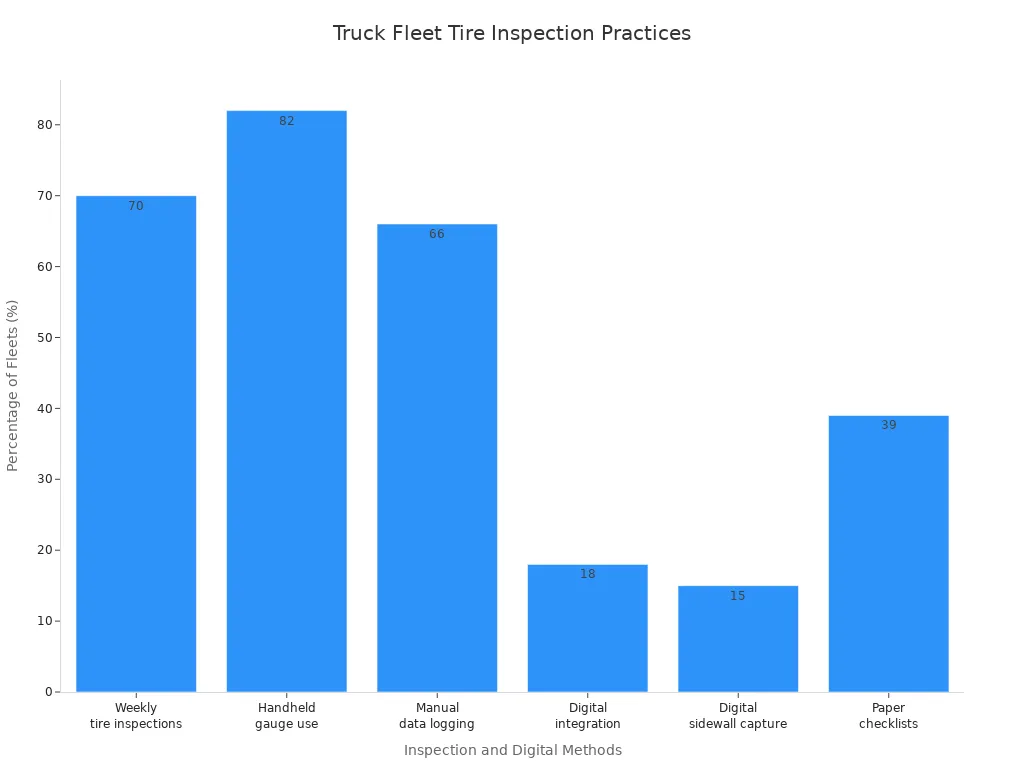
In the trucking industry, taking care of tires is very important for safety. Checking tires regularly helps you find problems before they get worse. Tire tread scanners are a new tool that checks tire wear all the time. These scanners give you instant information. They warn you about issues like too much wear or low air pressure. This way, you can stop blowouts and other dangers, making vehicles much safer. In 2024, tools like tire pressure monitoring systems (TPMS) have shown great results. They have cut down tire failures by more than 80%. This shows how important it is to take care of tires to keep your trucks safe and running well.
Belangrijke punten
Tire tread scanners use lasers and smart tech. They measure tire wear fast and accurately. This helps stop dangerous blowouts.
Checking tread depth often with these scanners makes vehicles safer. They find worn tires early and lower accident risks.
Using tire tread scanners cuts maintenance costs. They find uneven wear and tire problems before they get expensive.
Connecting tread scanners with fleet management systems helps check tire health in real time. This helps plan maintenance better.
Future scanner upgrades will improve accuracy. They will connect with safety systems, making trucking safer and more reliable.
Tire Tread Scanner Functionality
Tire tread scanners use smart technology to keep your truck’s tires in great shape. Knowing how these tools work helps you see how they improve safety and efficiency on the road.
Laser Scantechnologie
Laser scanning technology is the main part of tire tread scanners. This technology works by shining a laser beam onto the tire tread. Here’s how it works:
A laser beam makes a line of light on the tire.
Cameras take a picture of the tire where the laser hits.
The system fixes any image problems and changes the picture into real-world measurements.
The tire’s shape is taken out, showing the grooves.
The depth of the grooves is measured, giving you exact tread depth.
This method gives you quick and accurate tread depth data. The technology can also work with cameras and AI to make detailed 3D models of the tire surface. This helps with automatic and precise tread measurements. For example, systems like the TREADREADER use small laser sensors to gather up to 400,000 data points on the tire, making sure tire condition checks are reliable.
Tread Depth Analysis
Analyzing tire tread depth is very important for road safety. Tire tread scanners keep an eye on tread depth, temperature, and unusual wear patterns all the time. This constant checking helps you get early warnings, so you can change tires before they break.
The scanners use high-quality cameras and smart programs to check the tire’s condition. They find tread patterns, measure tread depth, and look at overall tire health. This information is turned into useful insights, like how much tread is left and any possible damage. You can get this info in real-time through easy-to-use screens, helping you make quick decisions about tire care.
By using tire tread scanners, you can lower the chance of blowouts. These scanners give a full tire condition check, helping you stay ahead of problems. With smart maintenance planning based on accurate data, you can improve fleet efficiency and driver trust.
Benefits for Vehicle Safety

Tire tread scanners are very important for vehicle safety. They help stop blowouts and lower costs, making your trucking work better.
Preventing Blowouts
Blowouts can cause serious accidents. Tire tread scanners help you avoid these risks by giving exact measurements of tire tread depth. Here are some important points about how they help with safety:
Worn tires have a much higher accident rate (26%) than good tires (2.4%).
Low tread depth raises risks like hydroplaning, longer stopping times, and losing control of the vehicle.
Tire tread scanners give quick and accurate measurements, so you don’t have to guess. This helps you find unsafe tires early and change them before accidents happen.
Regular checks with these tools find uneven wear, which helps prevent accidents and saves money.
By using tire tread scanners, you can follow legal safety rules, like having a minimum tread depth of 1.6 mm. This smart approach lowers the chance of blowouts and makes vehicles safer overall.
Reducing Operating Costs
Tire tread scanners not only boost safety but also help you save money. Here’s how they do this:
Tire tread scanners use HD cameras and LED lights to create a clear 3D image of tire tread. This helps find exact wear patterns, bald spots, and uneven tread.
Finding irregular wear early can show alignment or suspension problems. This lets you fix issues on time, like changing tires or aligning them.
The system connects tire health data to specific vehicles using license plate capture, which cuts down on mistakes and makes reporting easier.
The Tire Health Report is easy to understand and helps you accept maintenance advice.
Faster inspections mean quicker check-ins and better upsell rates, which can keep customers happy.
Overall, these features help plan maintenance, stop costly tire failures, and make fleets safer and more efficient. By investing in tire tread scanners, you can greatly reduce your operating costs while keeping your vehicles safe on the road.

Practical Applications in Heavy-Duty Trucks
Tire tread scanners are very important for safety and efficiency in heavy-duty trucks. They can help your fleet perform better and lower risks on the road.
Continuous Monitoring
Keeping an eye on tire health is key for safety and performance. You can use tire tread scanners to get real-time data about tire conditions. Here’s how it works:
Sensors like TPMS and RFID tags collect tire data such as pressure, tread depth, and temperature.
Software checks this data and sends alerts for low pressure, uneven wear, and maintenance needs.
This constant monitoring helps you find tire problems early, so you can fix them on time.
For example, big trucking fleets often use systems like Continental’s ContiConnect. This system has sensors on tires to track pressure and temperature. It doesn’t measure tread depth directly, but it estimates wear by checking mileage and overall tire health. Fleet managers can see this data on a web portal or mobile app, getting alerts and past information about tire conditions.
Fleet Management Integration
Connecting tire tread scanners with your fleet management software can make operations smoother and safer. The Anyline Commerciële Bandprofiel Scanner lets you quickly and accurately scan tire tread depth and sidewall info using mobile devices. This integration works with different development frameworks, making it easy to add to your current systems.
You can follow these steps for good integration:
Look at your current tire inspection processes to find where technology can help.
Pick a tire tread scanner solution that meets your fleet’s needs, focusing on how it can integrate.
Train your staff on how to use the new technology.
Connect the scanner with your fleet management software to keep vehicle maintenance data in one place.
By doing this, you can use tires better, save money, and improve vehicle uptime. Aperia Technologies’ Halo Connect system shows this integration well. It combines tire tread data with asset tracking and smart analytics, giving maintenance recommendations. This method improves safety by ensuring timely tire replacements and following regulations.
Adding tire tread scanners to your fleet management plan not only increases safety but also helps with efficient maintenance scheduling. This leads to a more reliable and cost-effective operation.
Future Innovations in Tire Scanning
As technology gets better, tire tread scanners will also improve. These new features will make them more accurate and help them work better with safety systems. This will make trucking safer and more efficient.
Enhanced Accuracy
Better accuracy in tire tread scanners helps you find tire wear and problems clearly. Here are some important benefits:
Improved Grip and Braking: Accurate measurements help vehicles grip the road better. This makes braking safer and lowers the chance of accidents like blowouts and skidding.
Timely Maintenance: High-precision sensors check tread depth and find uneven wear. This lets you fix issues early, helping tires last longer and making replacement easier.
Batch Inspections: The scanners work quickly, which is great for fleet management. You can do batch inspections fast, improving maintenance and helping you make smart decisions.
Predictief Onderhoud: Accurate tread data helps you avoid emergencies on the road. This keeps your vehicles safe and on the road longer.
Integration with Safety Systems
Connecting tire tread scanners with advanced safety systems changes the game for trucking. Here’s how this connection works:
Realtime monitoring: Systems like Aperia Technologies’ Halo Connect i3 give real-time updates. They find uneven wear, mismatched tires, and alignment problems, allowing for early service suggestions.
AI-Powered Scanning: Companies like Elscope Vision are making AI tire sidewall scanners. These scanners take clear pictures and find defects automatically, reducing mistakes.
Cloud Connectivity: Using cloud technology lets you add inspection data to fleet management systems. This helps you make real-time, smart maintenance choices, improving safety and efficiency.
Remote Adjustments: Fleet managers can change tire pressure settings from afar. This feature helps keep tires inflated correctly, boosting performance and safety.
These new features will change how you take care of tire health, making your fleet safer and more efficient.
Tire tread scanners are very important for keeping vehicles safe. They give you real-time information about tire health. This helps you check tread wear and stop blowouts. Studies show that using sensor data can help predict tire wear better. This lowers the chance of accidents. About 11,000 crashes happen each year in the U.S. because of bad tire conditions. By using tire inspection tools, you can make sure maintenance is done on time and improve tire replacement. This smart way of working not only makes safety better but also helps your fleet run more efficiently.

Veelgestelde vragen
What is a tire tread scanner?
A bandenslijtage scanner is a tool that uses smart technology. It measures how deep the tire tread is and checks the tire’s condition. It gives you real-time information. This helps you keep an eye on tire wear and avoid blowouts.
How does tread depth analysis improve vehicle safety?
Tread depth analysis helps you find worn tires that can cause accidents. By checking tread depth often, you can change tires before they break. This makes your vehicle safer overall.
Can tire tread scanners reduce maintenance costs?
Yes! Tire tread scanners help you find uneven wear and other problems early. This way, you can fix things on time. It lowers the chance of expensive blowouts and helps tires last longer.
How often should I perform tire inspections?
You should check your tires regularly, at least once a month or before long trips. Using a tire tread scanner can make this easier and ensure you get accurate tire condition checks.
What are the benefits of using technology for tire management?
Using technology for tire management makes measuring tread depth more accurate and boosts safety. It helps you track tire wear better. This leads to smarter maintenance choices and lowers the risk of accidents.
Zie ook
Understanding How Smart Devices Measure Tire Tread Depth






